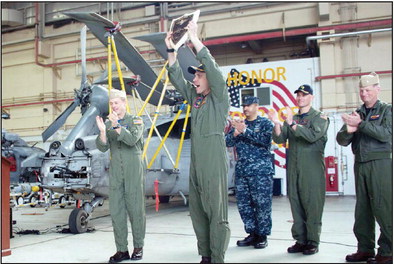CDR. McQueen wins ‘Battle E’

CDR. McQueen wins ‘Battle E’
Son of West Memphis couple awarded coveted Naval honor
ralphhardin@gmail.com The Battle Effectiveness Award (commonly known as the “Battle E”), is awarded annually to the small number of United States Navy ships, submarines, aviation, and other units that win their battle effectiveness competition.
The criterion for the Battle Effectiveness Award is the overall readiness of the command to carry out its assigned wartime tasks, and is based on a year-long evaluation. The competition for the award is, and has always been, extremely keen. To win, a ship or unit must demonstrate the highest state of battle readiness.
The Battle Effectiveness Award recognizes sustained fast and winning performance in an operational environment within a command. To qualify for Battle 'E' consideration, a ship must win a minimum of four of the six Command Excellence awards (Maritime Warfare, Engineering and Survivability, Command and Control, Logistics Management, CNSF Ship Safety, Efficiency) and be nominated by their immediate superior in command. Eligibility for the award demands day-to-day demonstrated excellence in addition to superior achievement during the certifications and qualifications conducted throughout the year. A ship’s performance during training exercises, weapons inspections, and tactical readiness examinations are among the 16 different areas that are considered in the competition.
Last month, Commander Ralph Lee “Tre” McQueen, III, commanding officer of Helicopter Sea Combat (HSC) Squadron 12, and his crew were the recipients of a coveted “Battle E.”
McQueen is the son of Lee McQueen and Carol Rich Cosgrove McQueen of West Memphis.
“As you can imagine,” said the elder McQueen, “we’re very proud of him, and what he and his crew were able to accomplish.”
CDR. McQueen was presented the honor during an “all-hands” call at the Naval Air Facility in Atsugi, Japan, by Vice Admiral Mike Shoemaker, commander of the U.S.
Naval Air Force Pacific Fleet. McQueen and crew were recognized for “demonstrating the highest overall readiness to carry out its assigned wartime tasks.”
Shoemaker presented HSC-12 with the award as part of his annual fleet engagement to forward deployed naval forces. Ships that win a battle effectiveness competition are authorized to paint a white 'E' with black shadowing on their stacks or elsewhere to display evidence of the honor. For each subsequent consecutive competition won, the ship paints an angled line, or hashmark, below the white 'E'. The very rare winners of five consecutive 'E's replace the white 'E' and hashmarks with a gold 'E' and
silver star just above.
By Ralph Hardin


Share